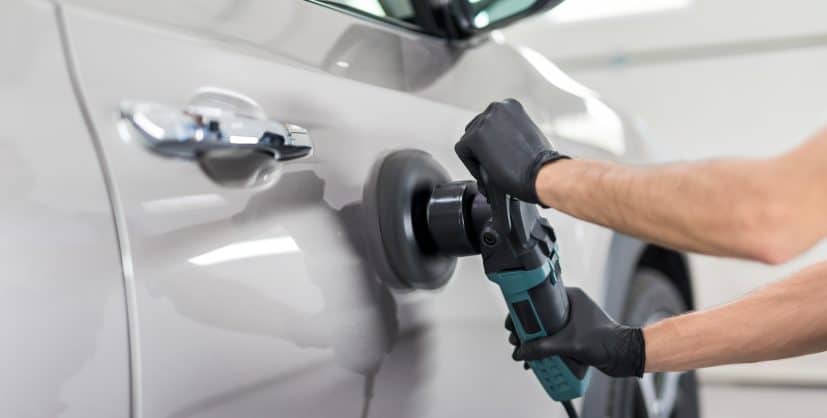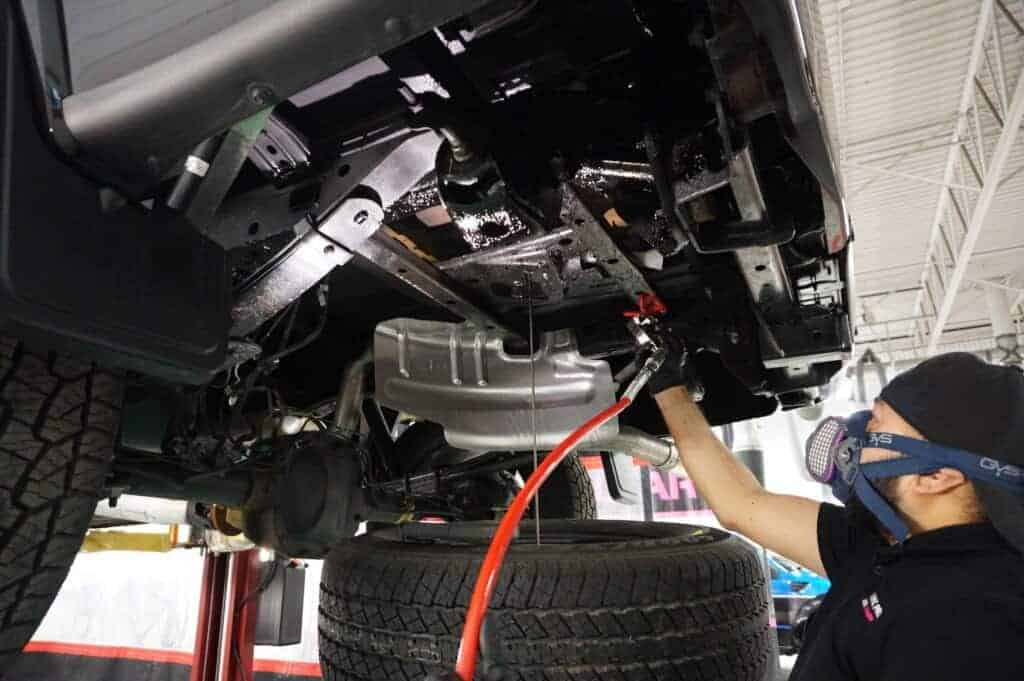Anyone who’s owned an automobile for an extended period, knows the agony of washing their vehicle, and discovering that their paintwork has been adorned with a shit-ton of super small scratches.
Spider webbing, or spider scratches, are diminutive paint imperfections that are widespread, super unappealing, and completely avoidable.
In today’s AvalonKing blog upload, we’ll talk about the difference between swirl marks and spider scratches, and the root causes of each issue. We’ll also discuss the role that “dry paint” and its enablers play in accelerating the proliferation of spider webbing surface scratches.
While we’re at it, we’ll also discuss how poor car ownership practices cause spider scratches to form, along with the best DIY techniques for reducing their impact on a clear coat. The act of removing these surface flaws from a vehicle is not as difficult as one might think, especially when the right tools and know-how are put in place.
So break-out those reading glasses, crack open a cold one, and let’s get rid of these automotive cobwebs!
Where Are These Damn Spider Scratches On My Car Coming From?!

Did you know that your car’s clear coat and your skin are strikingly similar in how they perform when they start to dry-out?
Both of these protective outer layers rely heavily upon the hydration found within naturally occurring oils to reduce the risk of damage.
Unfortunately, harmful outside influences, like UV radiation, changes in temperature, and airborne contaminants have other plans, causing the natural oils encapsulated within our skin and our clear coats to dry-out.
While car wax manufacturers will insist that the oils within their products will “rehydrate” painted surfaces and moisturize clear coatings, there is only so much that these surface protectants will remedy. There is no “spray and walk away” remedy on the planet that is going to eliminate paint spider webbing, and the average automated car wash is only going to make matters worse.
And while we’re on the topic of the local automated car wash, let’s make something abundantly clear: These machines are the damn devil.
People see caked-on contaminants clinging to their dried-out clear coat like a Speedo on an Olympic diver, and their first reaction is to haul ass down to the local automatic car wash.
Hold your horses there Mr. Clean…
All of those filthy bristles and polishing pads are probably the reason why you’ve got spider scratches in the first place, so you can go ahead and “scratch” the local auto car wash off the list of potential spider webbing solutions.
And throwing a random household cleaning cloth and a splash of dish soap at the situation is only going to make matters worse too. Things like line-dried cotton towels will scratch the ever-loving hell out of an aging paint job, while all of the harsh pH levels of dish soap will result in the formation of even more spider scratches. So stick with a clean microfiber cloth if you want to prevent future spider webbing from developing, and buy a pH balanced automotive shampoo for wash day.
Explaining Spider Webbing Scratches

Web-looking imperfections like spider scratches are typically the direct result of a clear coat losing its self-lubricating capabilities. A deeply dried-out clear coat can be marred by even the softest microfiber towel, especially if it is contaminated with debris or rubbed the wrong way.
As the image above illustrates, these scratches tend to materialize in a circular pattern, and are most noticeable when reflections are cast, either from direct sunlight or man-made illumination.
Quick Nerd Note: You’ll typically find spider scratches standing out on dark-colored vehicles, as they are lighter in color, and therefore are far more noticeable when placed in contrast to the dark paint’s pigments.
What’s the Difference Between Spider Webbing Scratches and Swirl Marks?
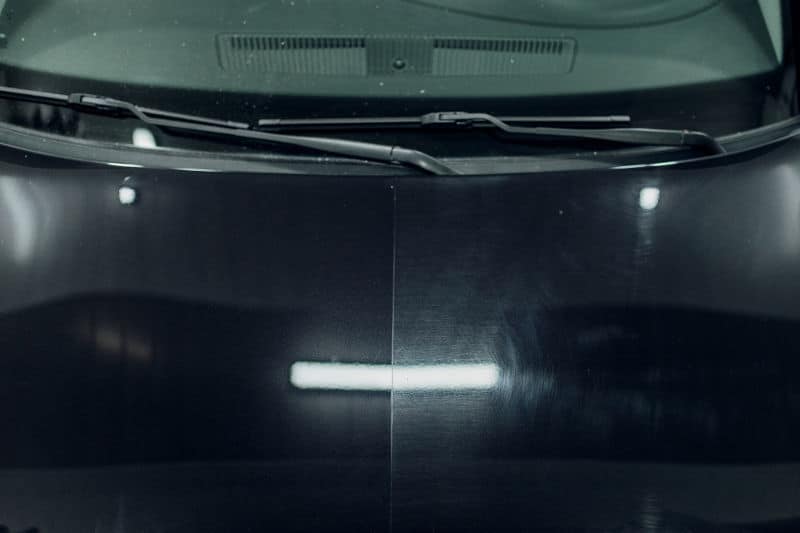
So while they may appear identical, there are some differences between a spider webbing and swirl marks. The following is an abbreviated overview of the distinction between the two.
Swirl Marks

Swirl marks are light surface scratches that are so fine, that they can oftentimes be buffed-out with the right detailing gear over the course of an afternoon in the garage.
Ironically, these superficial blemishes are often formed during the car cleaning process, or by improper waxing techniques. This is why using a side-to-side, or up-and-down motion is recommended over the circular, “wax-on, wax-off” Mr. Miyagi method.
Swirl marks can also be caused by not fully removing a surface polish, wax, or other form of protectant. People tend to forget that a little bit of protection goes a long way, and that when left to harden after being rubbed in a circular motion, these chemicals may cause scratches and swirl marks to develop.
Spider Webbing Scratches

Spider webbing, on the other hand, tend to appear when light is refracted through the clearcoat at a certain angle, and oftentimes is not a scratch at all, but an ultra-thin crack in the paint or clear coat.
These sorts of “scratches” tend to be deeper than swirl marks, and oftentimes are the direct result of clear coat neglect, where it is allowed to dry to the point where it cracks. You can also get spider webbing from not using a super-plush microfiber towel to dry the vehicle, applying an overly aggressive polishing compound to its exterior, or scrubbing your ride with a dirty wash mitt.
We’re not kidding when we say that the average cloth or towel will royally wreck a clear coat, too. Even the slightest amount of pressure from a shop towel, cotton cleaning cloth, or other semi-abrasive form of drying media, will cause spider webbing to materialize faster than hooded ninjas in the night.
Hell, even a chamois cloth will cause this spidery shit to manifest, so be sure to stick with microfiber drying materials, don’t forget to remove the tags, and never move your hand in a circular motion.
Quick Nerd Note: Swirl mark and spider webbing prevention begins with accurate information, and relies heavily upon proper car cleaning etiquette and routine maintenance. For more information on how to clean a vehicle, check-out our article on how to properly scrub and dry an automobile.
The Issue With Removing Spider Scratches From a Car

Since spider webbing tends to be more of crack in the paint or clear coat than a scratch, removal procedures can be a bit more demanding than those required for swirl marks.
With swirl marks, you can oftentimes smooth-out the afflicted area with a polishing tool that’s been outfitted with a mild polishing disc and super gentle polishing compound. There are even situation when a quick buffing will cut the kimchi, thus eliminating the need for abrasive compounds and resurfacing pads.

But because spider webbing is the result of a painted surface cracking, you are going to need to first smooth and resurface the compromised area. This means implementing a paint correction procedure, where a variety of aggressive cutting compounds and polishing pads in an array of grit gradients and thicknesses are put to use.
It’s a slow and detail-oriented process, but as you progress from one polishing compound and pad to a milder combo, you will begin to eliminate the spider webbing. This procedure is called “paint correction,” and there is far more to it than its name implies, which is precisely why we made a our guide to correcting car paint like a pro.
When Are Spider Scratches Fixable?

In order for spider webbing to be neutralized in a timely fashion, it must first be identified and quarantined. If allowed to fester, the spider webbing effect will continue to crack the paint and clear coat, and slowly spread to other areas of the vehicle.
A general “rule of thumb” for ascertaining whether or not you can easily fix a spider webbing scratch, is to actually use your thumb, and give the damaged area the old “nail test.” By gently running your thumbnail across a scratch, you should be able to detect whether or not it is so deep that it catches and makes a faint sound. If you can hear, or feel the scratch, then chances are it’s too deep to repair without implementing paint correction procedures.
Quick Nerd Note: Anything that transcends the clear coat, and becomes etched or cracked into the underlying paint, primer, bare metal, or plastic, must be amended with a full surface repair procedure. This is something that is best left to a professional, as it requires experience, tools, and a space to spray fresh paint and clear coat.
Steps for Removing Spider Webbing From Car Paint

Removing spider webbing and other forms of moderate clear coat scratches first requires the leveling and relocation of the coating. This allows the afflicted area to be back-filled with clear coat from another area, and then adequately blended with its surroundings. The deeper the scratch, the more clear coat must be heated, relocated, and leveled, with extreme cases requiring the transparent paint’s complete removal.
Regardless as to whether you are going toe-to-toe with spider webbing, or sweeping away swirl marks, their removal often requires the use of a cutting compound and a polishing tool with the right buffing pads.
The goal with this method is to carefully remove one layer of clear coat after another until you reach the same depth as the swirl or spider webbing, which can be a bit tricky. You want to remove just enough clear coat so that you smooth-out the surface, without cutting too deep, or you’ll compromise the coating’s ability to protect the underlying paint.
How to Level Automotive Clear Coat
- Using either the two-bucket wash method, or if not heavily contaminated, the IPA wipe-down approach, remove all surface contaminants.
- Begin applying cutting compounds in descending levels of strength with the strongest compound being the first to be applied to the microfiber polishing pad on the electric polisher.
- As you work, gradually move from one compound strength to the next, making sure to routinely replace the microfiber cutting pad, as it will begin to dirty and develop areas of clear coat build-up.
- Working slowly, with even amounts of mild pressure, continue to polish the damaged area with the varying grades of compound, until the scratches are completely undetectable.
- Rinse and wipe the entire area dry one more time, being sure to use clean microfiber cloths, while always working in a side-to-side or up-and-down motion to avoid swirl marks.
- Finish with a thorough round of buffing with a fluffy buffing wheel to remove any lingering cutting compound, as it will simultaneously lift surface haze, and add shine.
Quick Tip: Spider webbing removal and repair falls into intermediate DIY territory. If you feel unqualified to tackle this process, do yourself and your automobile a favor, and hand this clear coat fix over to a professional detailer or a reputable auto body repair shop.
How to Protect Your Automotive Paint After Removing Spider Webbing

While there are a plethora of scenarios that can lead to the development of spider webbing and swirl marks, knowing how to remove them via a DIY paint correction procedure is vital. When properly implemented, and then followed by the installation of a paint protection product, like Armor Shield IX nano ceramic coating, the whole swirl mark and spider webbing snafu no longer becomes such a concern.
Here are a few of the most common forms of clear coat surface and automotive paint protection, with a bit of information regarding their inherent pros and cons.
Car Wax

While natural carnauba wax provides a lengthy lineup of protective oils to aid in bolstering the resiliency of clear coats and paints, it only lasts a few months, and is not nearly as tough as many other surface protectants. If you must use a car wax, opt for a paste, as they tend to contain the most natural oils, which in turn helps lubricate the clear coat and protect against UV rays.
However, there’s a reason why professional car detailers tend to refer to car wax as the “low SPF sunscreen” of automotive surface protectants. This stuff only shields surfaces for a short period of time, and it won’t do shit against things like spider webbing and minor scuffs.
Paint Sealants

When compared to traditional car waxes, paint sealants do a far better job of blocking the harmful elements that lead to paint fatigue and drying. Stronger than natural and synthetic waxes, but milder than the following two surface protectants, automotive paint sealants reside somewhere between hardcore and ho-hum.
Paint sealant products only last about a year on average before requiring removal and reinstallation too, a procedure that is considerably more labor intensive than stripping and reapplying car wax.
Paint Protection Film (PPF)
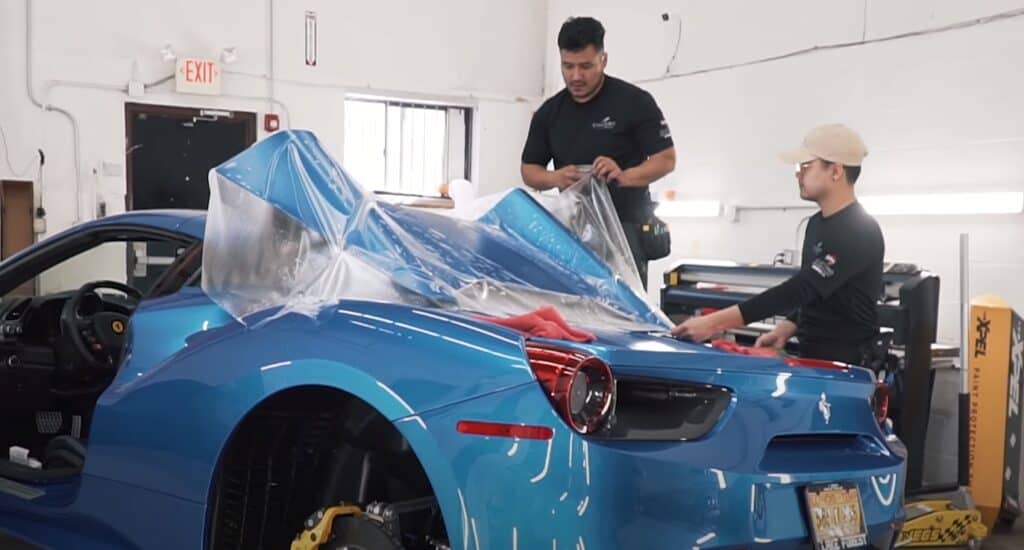
When it comes to all-around resiliency and lifespan, paint protection films (PPF) are pretty tough to beat. Once properly applied and allowed to cure, these hardcore, ultra-thin polyurethane membranes form a super-strong protective layer that resists most forms of superficial surface damage. Spider webbing, swirl marks, bird shit, tree sap, brake dust, tire scuffs, aerial attacks from extraterrestrials… it all gets deflected by PPF.
But there are some downsides to PPF, with the biggest issue being its inability to be installed via common DIY methods. Notoriously finnicky, and quite large in size, a PPF install requires a team of professionals, and is therefore quite expensive. The same goes for a PPF’s removal, as years of abuse and extreme temps cause it to turn into a brittle shell of its former self, one that has to be lifted with specialized tools wielded by trained professionals.
Nano Ceramic Coatings
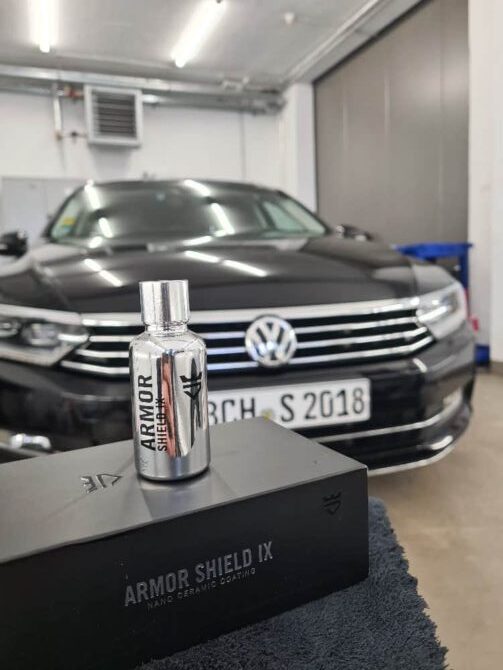
Perhaps the most balanced product in the evolutionary art of paint protection, are nano ceramic coatings. These products use specialized nano quartz crystals to penetrate into all of the microscopic imperfections on a clear coat to create a super slick, virtually impenetrable crystallized surface.
Once allowed to cure, 9H-grade nano ceramic coatings have the ability to repel a wide array of contaminants, therefore making things like spider webbing a non-issue. Nano ceramic coatings also tend to last a lot longer than many other surface protectants, with a 2-year protection guarantee providing peace of mind for all AvalonKing Armor Shield IX buyers.
Parting Shots

If there’s one thing you take away from this article, it should be that spider webbing on car paint is 100% avoidable.
All you have to do is routinely clean your automobile with the proper methods and gear, and throw down a solid layer of surface protection once you are done.
By taking the proactive approach, and applying a paint protection product, like a 9H-rated strength nano ceramic coating, you’ll take a huge step toward keeping that paint of yours from drying out. This will, in turn, help negate the risk of waking up to discover a bunch of unpleasant looking spider scratches on your clear coat, which last we checked, was a win-win for everyone.





